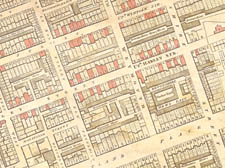| |

A 19th-century map of Harley Street and the surrounding area, modified by Dr Draper to show slave-owners’ homes marked in red |
Before doctors, Harley Street was floating on ‘slave money’
New research reveals how 19th-century Marylebone was a haven for West Indian slavers
HARLEY Street has been synonymous with medicine since Queen Victoria came to the throne. It is said that healthcare is so institutionalised on the street it is customary to measure time in terms of Before Doctors (BD) and After Doctors (AD).
But new research reveals a sinister side to the noble street that will send shockwaves through consulting rooms and operating theatres across Marylebone.
Before the white coats moved in, Harley Street and the surrounding area was the destination of choice for a more gilded class – slaveholders.
While sifting through scores of dusty archives and compensation claims of former plantation owners following the Slavery Abolition Act in 1833, University College London scholar Dr Nick Draper made the discovery that a whole “profession” of slave owners settled in the area at the turn of the 19th century.
The correlation between slave owners and home owners was so strong, he modified a 19th-century map which now forms the centrepiece of a new expiation called the Slavers of Harley Street, documenting the forgotten wave of migration and the spectre of slavery that haunts the street.
“One out of two houses was lived in by someone who had made money from slavery,” said Dr Draper. “A lot of them had made fortunes in the West Indies at the turn of the 19th century, and came back to London to join the ranks of high society. They came to Harley Street and Wimpole Street because more established areas like Mayfair wouldn’t have them. They were seen as tainted in those areas, so they chose Marylebone.”
Although it is common knowledge that slavery was a boon for commerce in London, with many famous institutions paid for with the profits of the heinous trade, the notion of a district of slave owners was until now completely unheard of.
Dr Draper says they chose Harley Street because the so-called “landed gentry” in Mayfair and St James‘s would not accept them. Not as you might think because of their reproachable ties with slavery, but because they were considered uncouth, brash and ostentatious new money.
“They set up a whole community, going to the same churches, coffee shops and clubs,” he said. “There was an influx of money into the area and it’s fair to say they brought it up in the world. You could say they formed a new class, with different values and customs.
“When most people think of Harley Street they think of doctors and not of a residential neighbourhood. But the slave owners predated the doctors. The doctors didn’t really come until the 1840s, at which time the community had kind of disbanded, either through people moving to richer climbs or making silly investments and going broke.”
Understandably, not everyone will be pleased with the historian’s diligent research.
Some prominent residents have emerged whose connections with slavery might raise a few eyebrows. Among them are poet Elizabeth Barrett Browning, MP George Watson Taylor, Lord Mayor John Atkins and lawyer JW Freshfield.
Slavery was abolished in most of Britain’s colonies between 1833 and 1838, and compensation was paid to the slave-owners rather than the enslaved, who received nothing. Under the Emancipation Act, the government paid out £20m over 40,000 separate awards.
Dr Draper’s next step will be to “follow the money”. “I had no idea the area was lived in by slave owners and it begs so many questions,” he said. “It’s the tip of the iceberg. I want to look at some of the buildings, infrastructure and societies in the area to see if they were born out of this new slavery money in Marylebone.
“That is really the next question because what has struck me about this research the most is just how quickly [the slave owners] became assimilated. In a generation, they went from tainted to naturalised, and slave money was flowing through the street.”
• |
 |
|
| |
| |